
When I was living in the Netherlands I made abstract, sculptural ceramics. You can see the sources of inspiration and the results of what I made in another article, but here I want to answer the question “Can you make ceramics at home?”.
In order to work properly, you do not need your own atelier – several of my students used their kitchen table – although a place you don’t have to tidy before every meal is an advantage.
The space I used was a small building located in the garden, which suited me perfectly. It was my atelier where nobody disturbed me and I could work quietly. And where I taught my students, so at times it was not quiet at all!
Some of the links are affiliate links. As an affiliate associate, I earn a small commission when you purchase any of the products offered through the shared links at no extra cost to you. This helps me to maintain this website and I thank you for supporting me.
Table of Contents
Can you make ceramics at home?
Even without a separate workplace, you can make ceramics at home. You don’t even need to own your own kiln as there are options to fire your work in other ways.
What you need to make ceramics at home
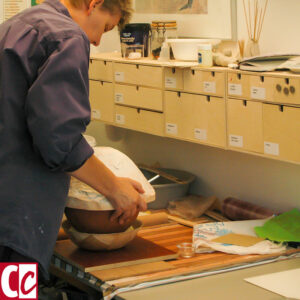
When you start making ceramics, you first have to find out if you like it enough to invest money and time in it.
Before you mess up a lot, it is enough to have some space in a cupboard and a place at a table.
Buy some clay, spread old newspapers on your table, find some stuff from your kitchen drawer, and you’re good to go.
If you conclude that you enjoy making ceramics, you can buy tools step by step and set up a working space.
Related: Start Making Ceramics Now with Clay Tools from the Kitchen Drawer

Every child is an artist. The problem is how to remain an artist once we grow up. ~Pablo Picasso
Do you need a kiln?
My studies in my teens were at the Academy of Visual Arts in Tilburg, the Netherlands, where I majored in ceramics. After that, I first started teaching, before founding and developing my own graphic design studio.
For some reason, my father’s death was the trigger for me to want to make ceramics again. But then I had nothing to do that – no workshop, no tools, no kiln, not even clay.
So even though I didn’t need lessons anymore, I nevertheless signed up for a course at an adult education centre. This allowed me to find out at my leisure what I absolutely needed and I had access to the centre store and a kiln.
Later, I hired space in the kiln of a potter, who lived nearby.
Another big advantage of hiring first is that you learn what you like or don’t like in a kiln. You’ll be so much more prepared when you are going to buy one.
Reflections on buying a kiln
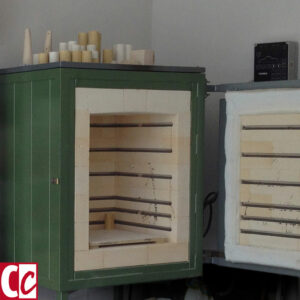
- Do you want a top-loader or a front-loading kiln? A top-loader is cheaper, a front loader is better for your back;
- What is the easiest energy source for you to access, gas or electricity? Take into account that some effects are not possible in an electric kiln. For example, you can’t regulate the oxygen inside, needed to fire raku;
- What size do you need? Making big pieces doesn’t necessarily mean needing a big kiln. Mine was 100 litres, but I still made pieces of 1,5 metres high. They were made in parts and assembled afterwards;
- Can you put the kiln outside your workplace? And if not, can you make an exhaust system?

- If it is electricity, do you have ordinary or high-voltage power? If you won’t fire higher than 1.060 to 1.100 degrees C you don’t need a high-voltage kiln. When you want to work with porcelain you do;
- Do you want a computer-regulated kiln? When I was a teacher at a high school, I had a small top-loader available with which I had to regulate the temperature by pyrometric cones. It’s not too hard but as you can imagine, a computer-regulated kiln is easier and more constant;
- How big is the space you have available?
Alternatives to a kiln
If it turns out that you can’t purchase a kiln because you have no space or no energy source, all is not lost. A pit fire is a good alternative.
You can make that in different ways. You can dig a simple pit. Or you can build one with bricks, as I show in another article:
Related: How to Smoke-Firing Ceramics for a Beautiful Decorative Result
My favourite hiding place, my workplace
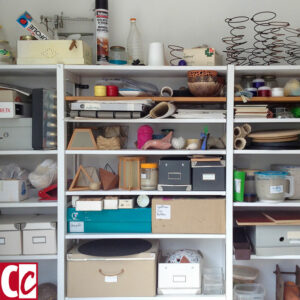
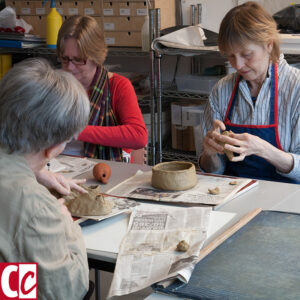
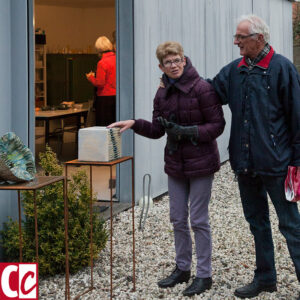
For me, it has always been hard to keep a surface cleaned up. In some areas of my life, I am a messy person. In my youth, both my mother and my sister used to yell at me: “Clear out your stuff!”
A big advantage of having groups of students at times is that I have to make sure they have room to work. To do that, I used shoeboxes and small drawers that were labelled to keep an overview.
Exhibitions
Yearly I had an exhibition in my house and garden, for which I invited 5 other artists to participate. Last time a blind woman visited. She was so happy that I allowed her to touch my ceramics.
Her husband next to her guided her and described the colours. There was a time she was not blind so she knew what the colours are.
Being sustainable as a ceramicist

Dirty business: Ceramics is a dirty profession. Your hands and your tools will get messy. Try to work as responsibly as possible.

Trying to live a sustainable life can interfere with being a ceramicist. In fact, ceramics is a dirty business. Several of my friends died prematurely because they hadn’t made any precautions while working.
Please don’t be another one on that list and try to work as sustainably as you possibly can. Your health and the environment both matter a lot!
A professionally installed ceramic studio has a deposit tank and an air outlet above the kiln. These are pricey investments.
Related: Why Water Management is Important and How We Can Contribute
Sustainable attitude
If you can’t afford a deposit tank from the start – like me – it’s just as easy to use 2 buckets. One for non-toxic stuff like clay, to rinse your tools and hands, and one for toxic waste like glazes and oxides. Don’t put your bare hands in the toxic bucket!
Actually, I worked with 4 buckets. When 2 of them were full of water I switched them. The water in the buckets would evaporate after which I spooned the remainder into a lockable bucket. When I had a lot of that, I brought it to the Environmental Centre.
Protect yourself
When you work with clay, your hands dry out. That’s no problem. However, coloured glazes and underglazes may contain heavy metals.
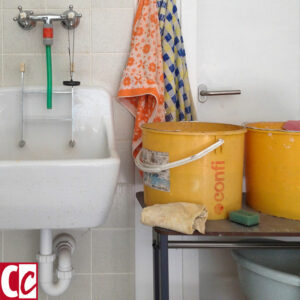
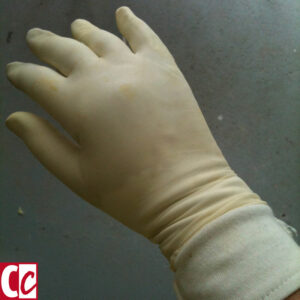
I always wore protective gloves when I glazed my work. Since I have eczema easily, I wore cotton gloves under the plastic ones.
Since I couldn’t afford exhaust air, I never fired the kiln when I was in my studio. One of the advantages of computer control was the ability to set time.
This way I could use the cheaper nightly electricity rate and the kiln started when I was not around. The workshop door was left ajar for venting and I didn’t go in until the kiln had cooled completely.
Do you have tips of your own concerning making ceramics at home? Please share them here in the comment box.
This article is an update. Originally published on 30-05-2013.



Reading your article once more, I am amazed by the experience of the blind woman. When you look at it, blind people lose out a lot, not being allowed to touch anything in musea. Whereas I am convinced that touching art, specifically monumental art pieces made of clay, stone, iron, or wood, can have a very strong therapeutic effect on blind people. And now I come to think of it, perhaps it’s good for everybody.
Of course, there are pieces of art we better not touch. Yet there are many statues in parks like Middelheim in Antwerp (Belgium), Insel Hombroich in Germany, and in the city of Münster, also in Germany, or the Rodin museum in Paris, and probably there are many more places, where they should really make an effort to help the disabled, not just the blind, to be able to physically experience the beauty of art.
Precisely, John, a tactile experience is good for everyone, not just the blind. I can’t remember exactly anymore, but I thought Middelheim is easily accessible for disabled people? Or maybe just a part of it. And because it is a public park, people can touch the statues as much as they want. Brilliant.
Thanks for your reply. 🙂
As I understand it correctly from your articles, you don’t make ceramic art anymore.
Yesterday, I saw a documentary about the piano player Thelonious Monk, a jazz musician. At a certain age, he stopped playing the piano altogether.
His argument was: “I’ve done everything I could and wanted on the piano.”
Is that why you stopped? Did you do everything you could and wanted with clay?
Such a great question. And I wish I could say yes but my quitting had more practical reasons:
* My husband and I were planning to emigrate from the Netherlands to Spain.
* For some time I was getting more and more uncomfortable with the environmental issues regarding glazes and such. So the first reason was a good ‘excuse’ to quit altogether.
Thanks for making me ponder, John, it’s always interesting when people make you rethink your decisions. 🙂 Have fun.